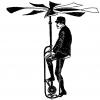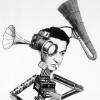Leaderboard
Popular Content
Showing content with the highest reputation on 09/28/2021 in all areas
-
Hey Gabe, You can lock the Wave. There is a single locking pin that is used to lock and unlock the wave during transport and operating. Personally I'd say the biggest difference is that the Wave is a single axis "stabilizer" where the Volt is a three axis motorized assist. Also, the Wave mounts to the top stage and the Volt is at the gimbal. Both require finesse in operating. The Wave, if not properly balanced, can get away from you and won't make your shots any easier (there is a video from Betz that explains how to get the camera's center of gravity set within the Wave, separate from the center of gravity on the sled itself). You also operate as you would with any "analogue" gimbal. The Volt has resistance controls that you can adjust which gives you more all around assist and freedom in your operating, still requires finesse, but is more forgiving. Since the Volt is balanced and generally operated in neutral, it will make those big roll moves you're talking about easier to achieve, especially with some of the electronic assist it provides in the motors. The Wave has no drop time requirements, it's solely based on the operators preference. Hope this helps.1 point
-
Hi Michael, It might be an operating issue as well. Some walking styles—and I'm categorically not saying better or worse here—exhibit more of a bounce than others. One of my favourite exercises is a the slow walk, and I always grab a rig at workshops and walk a line or two, so I've flown many G50s & 70s, and haven't experienced the bounce problem. I'll put ISO on full, then back it off till the arm flows. I usually back it further off in the inner section than the outer. I'll crank the lift up so each arm section rides a little high, then I'll bear down on the arm somewhat. Maybe this helps break the stiction. I look forward to experimenting more with the new bearings to see if they change my approach. All the best, Chris1 point
-
Charles, I think the point where the effort to boom all the way up or down was equal for the IIIa type arms was slightly below level, and the "equal effort" point for the single spring arms was slightly above level, hence the general recommendation. It's of little matter with the iso arms, so it's more a matter of feel - what you like. I tend to set the arm I use most (the G-70) slightly higher than level because I don't have as much power to boom up as I have to boom down, unless, of course, the shot is low, and then I let it float at the nominal lens height or close to it. If I have an extra minute, I'll set to arm to float so I do the least work. For Blair, it's most important that the section nearest the body (the upper arm) tracks with the forearm section. How you stand and walk (your posture) can affect how the arm behaves - so do all your adjustments standing in good posture with the rig in balance with you. Jerry1 point
-
If you had another camera that could shoot you while you were walking, that would give us more information on how to help you. Both of the guys had reasonable advice, even though seemingly contradictory. It's all in how you describe it. The arm (gimbal handle) hand is responsible for setting and maintaining the height of the rig; if you allow it to bounce with the up and down motion of your body, that will translate into the rig and cause the vertical movement you are seeing. If you are new or newish to operating, chances are you need to keep a pretty good hold on the rig to have it fly where you want (once you get solid with the hip to rig relationship, it is generally less critical as the rig will naturally fly alongside your body where you want it without having to be reined in). Let your arm be a separate entity from your body, from the shoulders down, and focus on your hand holding the gimbal at a constant height to the ground (while your body "bobs" separately). Same advice for your operating hand, of course. So as you can see this is somewhere between Blair's suggestion to grab on tight and Ken's to let it float. While it's not necessary to perform a handheld style walk, for some people their standard walk is too plodding and needs some smoothing out. This will make it harder to keep the arms from translating said plodding into the rig itself as discussed above. Most operator's walk with the rig ends up being somewhat smoother than regular walking but not as highly smoothed out as handheld. It does require you to maintain complete balance at all times and all speeds. I would indeed experiment with the tension of the arm (super simple, just the two knobs on top of the arm) as Ken suggests; too much tension will make the rig bounce. I wouldn't want to speculate on the vest without seeing it in action.1 point
-
Just got dailies back from a shot I did where I slowly walked through an airplane cargo hold. Pretty much one of the worst types of shots because there were plenty of strong horizontal and vertical lines to give away horizon errors, no actor to draw attention away from the background, and they wanted me to walk nice and slow. Well, the horizons looked pretty good and I felt pretty good doing the shot but watching dailies I cringed because it has a bit of a walking feel to it as opposed to a "camera on a string" feel. Wondering what sort of advice you all have regarding this. Loosen the spring tension? Walk a certain way? Dan1 point
-
Sometimes we all feel like a broken record (remember those?)... anyway, all these sorts of questions and concerns are worked on in workshops, this is basic stuff. So for basic stuff, take a workshop and get a comprehensive overview so that the bits of cherry picked advice given here on the forum fit into a larger picture ? rather than it is your picture. So many of the tips and ideas (even in short workshops) are useful only if you have some perspective... Sometimes even during a workshop it's very hard to figure out why someone's basic technique isn't working, there's some nuance of posture, handgrip, some combination of obscure things that come together to screw up the operating, and it takes a while to sort it out. Techniques that work for most or for one operator don't always translate well to others. One avenue other than the broken record, "take a workshop," route will soon be available for $20 - the re-mastered EFP Video training manual on DVD, with Ted and yours truly demoing the basics, about as comprehensively as possible in the time alloted. It's not a workshop; nobody's watching you operate closely over and over, but you can see what decent, basic technique looks like and what it gets you. And I look younger! And it's now so easy to ignore the EFP specific stuff (use the remote, Luke)... Jerry1 point
-
Based on this conversation, I put on the rig and did some movements paying specific attention to the level of control with each hand. My results indicate: 1. Gimbal hand - ALWAYS light touch. even when tilting. Only enough pressure to control the shot. 2. Non-operating hand, boom hand, hand that controls the arm, whatever. - Slightly stiffer grip when booming but when walking, especially slow, very light touch. The more I grip with this hand the more my slight momnetum changes get tranlated through to the arm showing my footsteps. Thanks for that. I've gotten into a specific feel of operating and making myself isolate different areas of input to the rig and seeing the result has been a good eye opener. Proper rig adjustment is the key and letting the rig do what it is designed to do is working better than over controlling. I remember seeing a clip of GB rounding a corner and walking with the rig and not touching it at all. I can't imagine really operating like that but the point he was making was that the rig does what it is designed to do, don't mess it up with too much human input. Do only what you need to do for the shot. All this is most likely obvious to experienced ops but for my learning experience it has been a good thing. Best, Kevin1 point
-
You shouldn't have to walk any differently. As you can see above there are lots of opinions... and many of them valid. It's very important to have tuned your arm properly. The key here is that both sections are working together... so if you find one bone bottoming out before the other... then you're not tuned right. They should both hit the bottom and top of their range simultaneously. However, the type of arm DOES make a big difference in performance. Having started years back with an SK arm (only one articulating section), then going to a pro-vid arm (basically 2 x SK Arm Sections), and now owning an Ultra Arm... there's a huge difference between arms. Design is everything, and there have been vast improvements over the years. For instance, with the G50 and G70 arms you have the ability to tune your ride. This is a really powerful feature! And finally, there's operator technique. As always, you want to be flying the rig with your body... and your hands should be doing as little as possible to get the shot. If you're fighting the rig at all... you're screwed. Good Luck!1 point
-
Your arm controls the arm in space, and you are the only thing that will ultimately dampen the spring action of the mechanical arm. Better, more iso-elastic arms will require less effort to dampen, but ultimately, it's your insistence on a given height and path that will keep the rig there. Shots without actors bobbing about are tough to keep perfectly on line (no distractions), but then buildings don't miss their marks, jump out of frame, or forget lines... Practice, practice, practice. If it were easy... Jerry1 point
-
I second that, loosen the springs so that your Gimbal arm, (as opposed to your post arm), is carrying more of the weight- thus lessening the effectiveness of the Steadicam arm. It will add a glide to your stride, and a dip from your hip will not disturb the mothership. Hope that it helps. Funky, CP1 point




